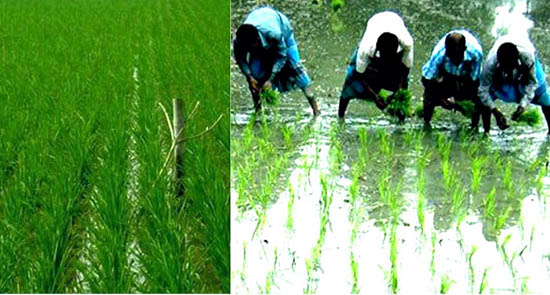RANGPUR, March 20, 2021 (BSS) – Aush rice cultivation largely expanded
in Rangpur region for eight consecutive years following various steps like
distribution of intensives, conducting motivational campaigns and providing
technical support to farmers.
Officials of the Department of Agricultural Extension (DAE) said
cultivation of less irrigation water consuming and short duration Aus rice is
expanding constantly following the time-befitting and pragmatic steps taken
by the government in recent years.
This year, the DAE has fixed a target of bringing 62,199 heaters of land
under Aush rice cultivation to produce over 1.75 lakh tonnes of clean rice
(2.63 lakh tonnes of paddy) for all five districts of the region.
The farmers have already prepared Aus rice seedbeds on 200 hectares of
land against the target of preparing the same on 2,984 hectares in Rangpur,
Gaibandha, Kurigram, Lalmonirhat and Nilphamari districts of the region.
“Transplantation of Aush rice seedling will begin from May and will
continue till the first week of June next,” Additional Director of the DAE
for Rangpur region Agriculturist Khandker Abdul Wahed, told BSS.
He said farmers produced 51,722 tonnes of Aush rice from 17,523 hectares
of land in 2013 while 59,685 tonnes of rice from 19,205 hectares in 2014 and
61,676 tonnes of Aush rice from 21,063 hectares of land in 2015 in the
region.
Farmers produced 65,505 tonnes of Aush rice from 21,751 hectares of land
in 2016 while 73,543 tonnes of Aush rice from 24,717 hectares in 2017 and
1.23 lakh tonnes of Aush rice from 40, 618 hectares of land in 2018.
Farmers produced 1.48 lakh tonnes of clean Aush rice from 47,552
hectares of land despite damage to the crop on 7,754 hectares of land by
floods in 2019.
Besides, farmers produced 1.83 lakh tonnes of clean Aush rice from
59,092 hectares of land even after damage to the crop on 4,598 hectares of
land caused by floods in 2020 in the region.
“Apart from carrying out motivational campaigns for Aush cultivation,
the government continues distributing special incentives in terms of quality
seeds and fertilisers among farmers free of cost every year,” Agriculturist
Wahed said.
Senior Coordinator (Agriculture and Environment) Agriculturist Mamunur
Rashid said Aush rice cultivation during the off-season between Boro rice
harvest and Aman rice seedling transplantation has already become popular
among farmers in the region.
He said various steps of the government like distribution of special
incentives and reaching latest technologies to farmers’ doorsteps are
effectively inspiring them in expanding Aush rice farming in the region.
“Besides, innovation and popularisation of the ‘Short duration Aman
rice-potato/mustard-Aus rice’ cropping pattern and providing high yielding
BRRI dhan48 variety of Aush rice are encouraging farmers in Aush rice
cultivation,” he added.
He said there is a brighter prospect to further enhance cultivation of
Aush rice using unused seasonal rainwater as an additional crop on the lands
that remain fallow during the off season to increase annual rice production.
“After harvesting Aush rice by mid-August, farmers can easily cultivate
Aman rice on the same land to enhance rice production for attaining
sustainable national food security amid changing climate,” Agriculturist
Rashid added.



